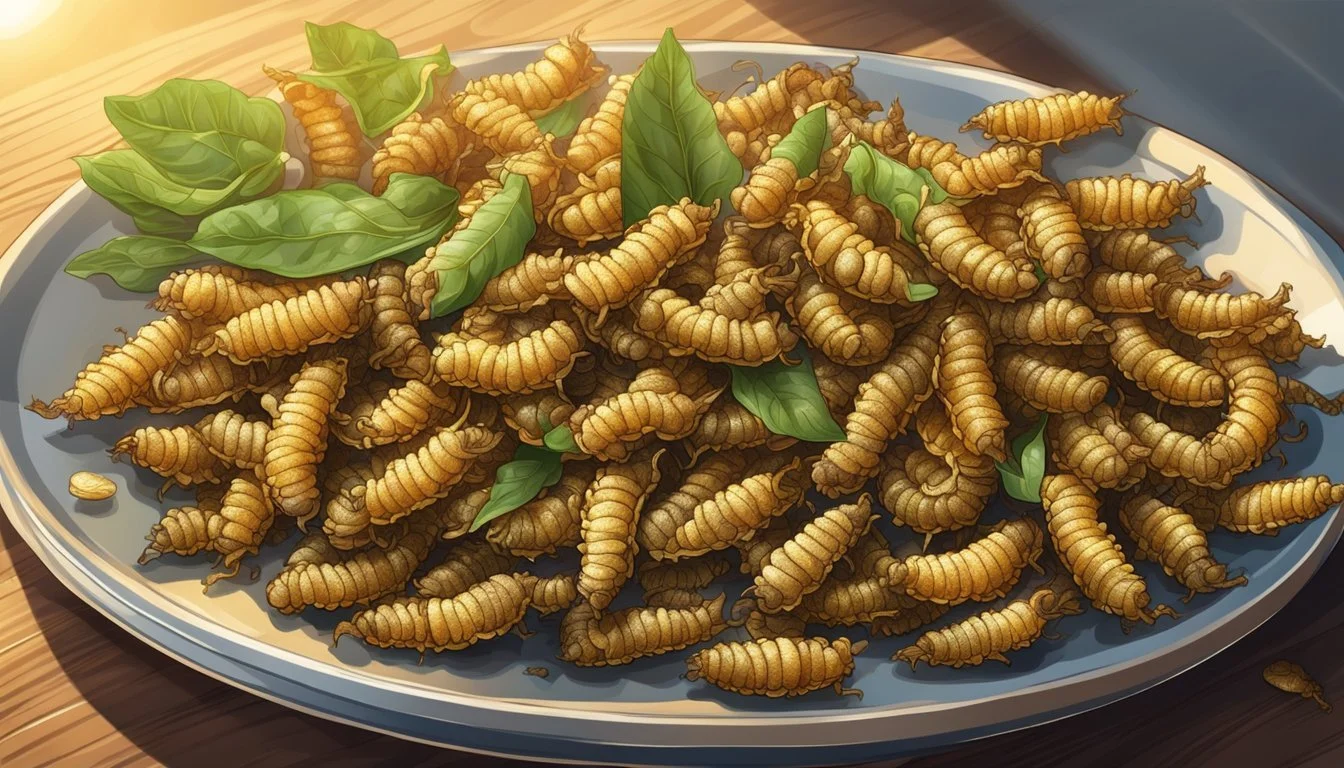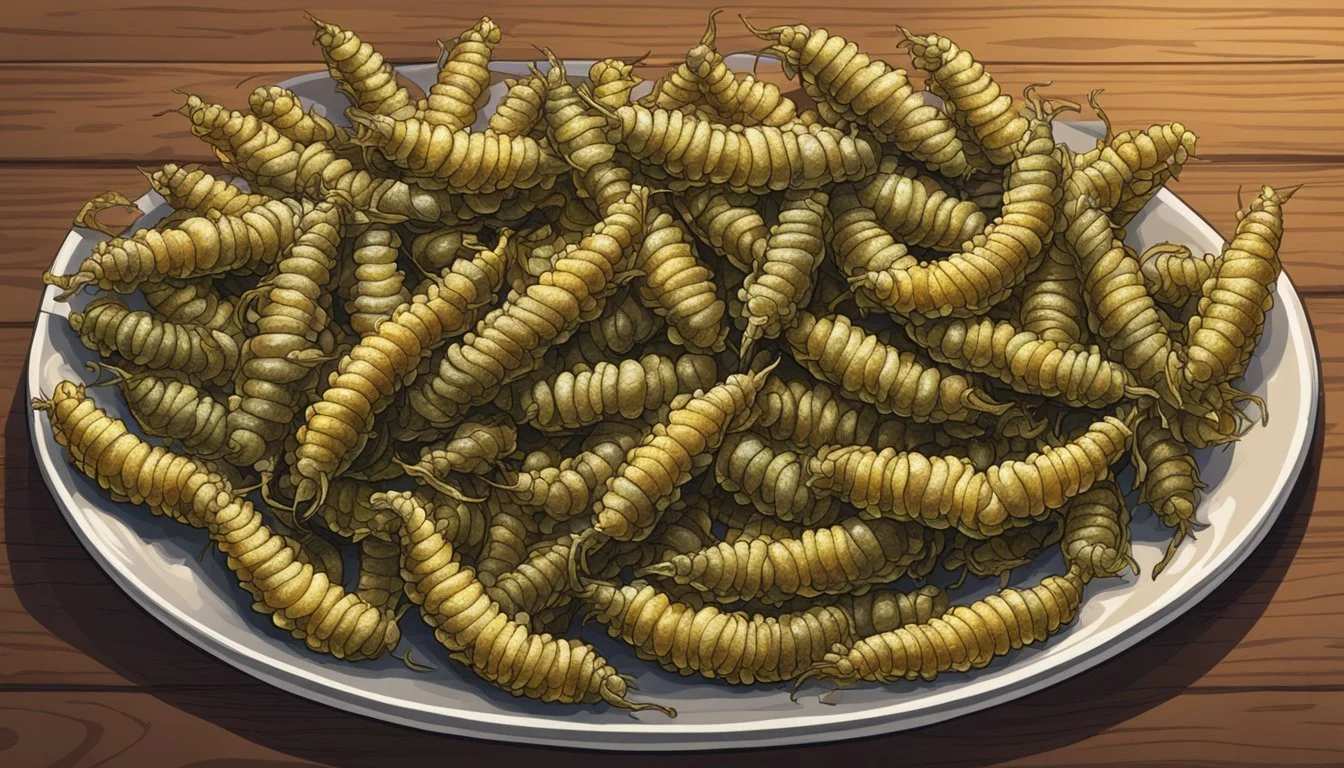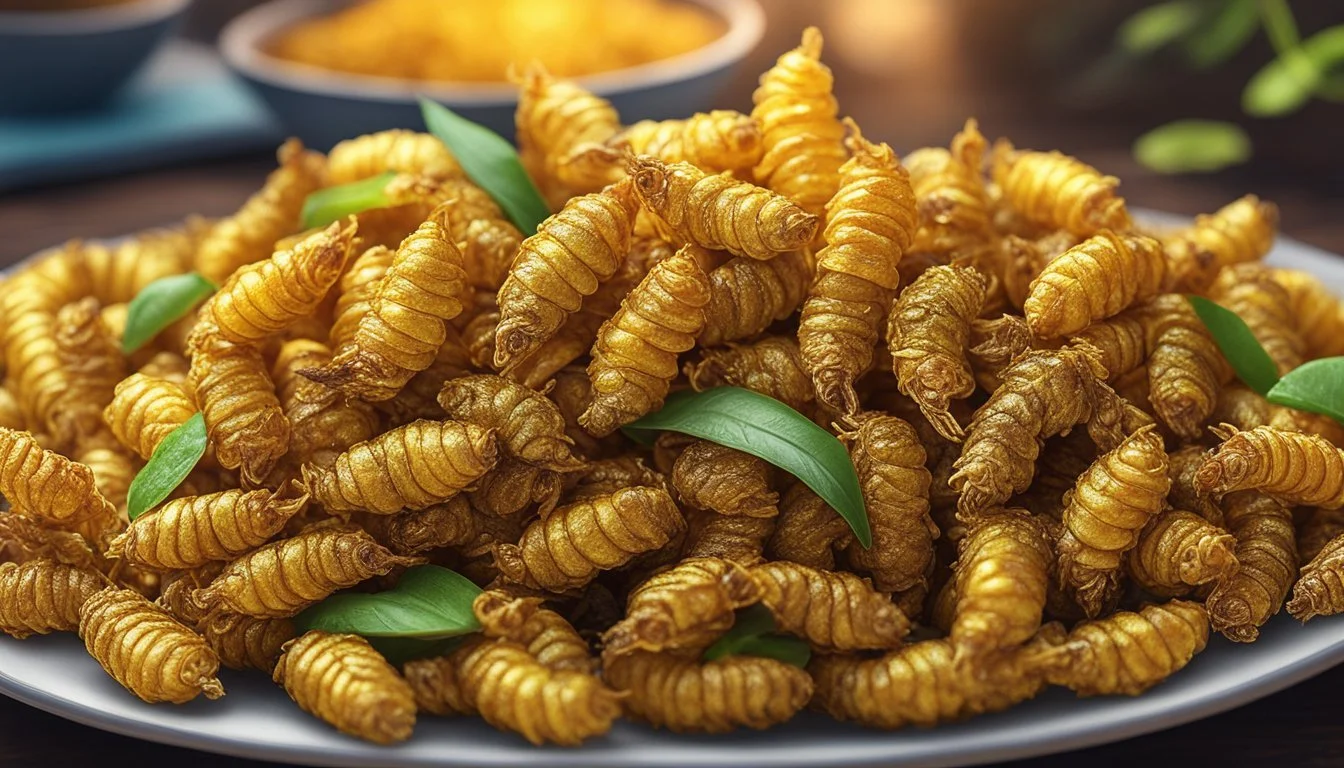Fried Silkworms
Unwrapping Thailand's Unique Culinary Delight
In the bustling street food scene of Thailand, fried silkworms stand out as a delicacy that offers a window into the nation’s rich culinary culture. Often found in the vibrant markets of Bangkok and throughout the northeastern regions, this snack is appreciated for its unique texture and flavor. As a staple of Thai cuisine, these crispy morsels are not only a source of protein but also a testament to the innovative use of local ingredients.
The process of preparing fried silkworms is simple yet precise, creating a snack that is crispy on the outside and tender on the inside. Silk worms, which are cultivated primarily for their silk throughout their larval stage, find a second purpose in Thai gastronomy. After being boiled, they are deep-fried to perfection and seasoned with various blends of salt, pepper, garlic, and sometimes a special vendor-specific sauce. The result is a crunchy treat that is commonly compared to more familiar snacks (What wine goes well with snacks?) such as potato chips, which challenges and delights the palate of those willing to explore the diversity of Thai street food.
Cultural Significance in Thailand
Fried silkworms are considered a classic example of Thai street food, reflecting the country’s rich tradition of edible insects. As a delicacy, they occupy a special place in Thailand’s culinary landscape. It is not uncommon to find vendors in Bangkok and Phuket offering these crispy treats, which reveal a surprisingly smooth texture inside.
Street Food Scene: Throughout the vibrant streets of Bangkok, fried silkworms are a testament to the adventurous eating that is a hallmark of Thai culture. They are often enjoyed alongside other exotic snacks, reinforcing the Thai enthusiasm for a diverse palate.
Temple Festivals: During certain religious and cultural festivals, Thai temples become hubs for traditional food. Here, fried silkworms are sometimes consumed as part of the celebratory feasts, signifying their role in Thai heritage.
Preferred by Locals: While tourists may be intrigued by the novelty, locals favor silkworms for their taste and texture, often considering them a nostalgic snack linked to memories and regional identity.
Bangkok: Association with Fried Silkworms - Street food markets, novelty snacks
Phuket: Association with Fried Silkworms - Traditional feasts, tourist curiosity
Rural Areas: Association with Fried Silkworms - Homestyle cooking, cultural legacy
Fried silkworms embody the innovative spirit of Thai cuisine, showing how traditional ingredients can be transformed into cherished snacks. They serve as a bridge between the rural origins of Thai snack foods and the bustling city food scenes, contributing to the complex tapestry that is Thailand’s food culture.
The Basics of Fried Silkworms
Fried silkworms have become a snack of choice for those seeking both protein and novelty in their diet. This edible insect dish is typically encountered on the streets of Thailand, where it is savored for its unique texture and flavor profile.
Preparation begins with silkworm pupae, which are rich in protein. These pupae are typically boiled first, which makes them tender. Once boiled, they may be marinated with a combination of spices such as salt, turmeric, and chili powder—often accompanied by garlic, ginger, and a splash of vinegar.
Cooking involves deep-frying the pre-boiled silkworms until they achieve a desirable level of crispness. The process is generally conducted at a moderate temperature; this ensures that while the exterior takes on a crunchy texture, the inside remains pleasingly smooth.
Serving these insects might come with a sprinkle of salt and pepper or with a variety of sauces, depending on regional tastes or street vendor's secret recipes. The result is a snack that, while unusual to some, offers a balanced combination of crispy and creamy textures.
It is important to maintain an appropriate heat level during cooking:
Medium-Low Heat: Ideal for preventing the silkworms from burning.
Stir Frequently: Ensures even cooking and prevents sticking.
Consumption as a snack is not only influenced by taste but also by the nutritional benefits they provide, with their protein content being particularly noteworthy in comparison to conventional protein sources such as eggs.
While fried silkworms might not be familiar fare to everyone, they stand as a testament to the variety and adaptability found within the realm of food, reflecting both cultural heritage and culinary innovation.
Preparing and Cooking
In Thai cuisine, the texture and flavor of fried silkworms are cherished, often described as having a nutty and cheesy profile and yielding a silky smoothness inside their crispy exteriors when cooked. This section guides through the preparation, cooking, and serving of this unique delicacy.
Ingredients and Varieties
Thai street vendors typically use silkworms for this dish, but other edible insects like crickets and grasshoppers are also popular. Classic seasonings include salt, pepper, and sometimes a secret sauce unique to each vendor, enhancing the dish's aroma and flavor. The most commonly deep-fried variety are Bombyx mori, silkworms fed on mulberry leaves.
Common Ingredients:
Silkworms (Bombyx mori)
Salt and pepper
Specialty sauces
Cooking Methods
Silkworms are most often deep-fried in a wok until they achieve a crunchy texture on the outside. Heat must be carefully regulated to ensure a golden, crispy exterior without burning them. Some street foods also incorporate bamboo insects, adding a distinct flavor and crunch.
Heat oil in a wok.
Fry the silkworms till crispy.
Season while hot.
Serving Suggestions
Traditionally, fried silkworms are a street food staple, enjoyed straight from a cart and often paired with beer. They are typically served in small bags or containers for easy, on-the-go snacking, allowing people to relish the crunchy delight while exploring other street fares.
Typical Pairings:
Alone as a snack
With Thai beer
Dipping Sauces and Condiments
While the snack can be seasoned with just salt and pepper, it is often accompanied by a range of dipping sauces, including chili sauces, soy sauce, and vendor-specific secret sauces. These condiments can greatly enhance the flavor, adding a salty, umami, or spicy kick.
Popular Dipping Sauces:
Chili sauce
Soy sauce
Unique secret sauces
Nutritional Information
Fried silkworms are not only a novel culinary experience but also offer high levels of protein, making them a nutritious snack. The process of deep-frying adds fat, but overall, they are considered a more sustainable protein source than traditional livestock and are a part of the edible insects category in diets around the world.
Nutritional Highlights:
High in protein
Sustainable food source
Health and Dietary Considerations
Fried silkworms offer a unique inclusion to the diet that is both robust in flavor and substantial in nutritional content. These insects are a popular snack in Thailand, recognized for their crispy exterior and smooth texture on the inside. When considering their place in a balanced diet, it's essential to acknowledge their rich protein content. This makes them a viable alternative to traditional protein sources like beef and chicken.
Nutritional Information of fried silkworms is impressive; they contain essential amino acids and are a good source of nutrients for humans:
Amino Acids: Necessary for bodily functions such as tissue repair
Protein: Supports muscle building and maintenance
Lipids: Provide a concentrated energy source
Minerals: Essential for various body processes
Vitamins: Play a role in maintaining immune system and other body functions
Other insects like grasshoppers also share a similar profile, rich in protein and other nutrients, and are consumed in various culinary traditions around the world.
When adding fried silkworms to one's diet, individuals should consider any allergies and their own body's response to new foods. While fried silkworms are considered safe for consumption, they should be introduced slowly to the diet, particularly for those who have shellfish (What wine goes well with shellfish?) allergies, given the potential for cross-reactivity.
In summary, incorporating this food into the dietary regimen can offer diverse flavors and health benefits, provided they are consumed with attention to individual dietary restrictions and nutritional balance.
Buying and Storage
When it comes to purchasing fried silkworms in Thailand, one will often find them at local markets and street carts, especially in Bangkok where they are a popular snack. Less commonly, they might be available at convenience stores, wherein pre-packaged varieties are sold. The brand and packaging of these fried bugs can vary, with some producers offering different seasonings to entice a variety of palates.
After acquiring fried silkworms, proper storage is essential to maintain their quality. Whether they are homemade or purchased from a street vendor or store, they should be stored in airtight containers to prevent moisture from softening their crispy texture. Room temperature storage is suitable for short-term consumption, while for long-term storage, refrigeration can help extend their shelf life.
In terms of brands, those seeking pre-packaged fried silkworms may encounter a range of Thai brands known for their seasoned insects. The packaging will often include instructions for storage, ensuring the product remains fresh until its indicated expiration date.
Storage Summary:
Short-Term: Airtight container, room temperature.
Long-Term: Refrigerate in an airtight container.
Where to Buy:
Street Carts: Fresh, often prepared on-site.
Local Markets: Variety of preparation methods and seasonings.
Convenience Stores: Pre-packaged, branded options available.
By adhering to these storage guidelines, one can enjoy the unique experience of fried silkworms at their best quality and flavor.
Consumption in Local and Global Context
In Thailand, consuming insects is deeply rooted in local culture and history. Fried silkworms, in particular, have established a firm place as a delicacy and a nutritious snack. Visitors to the country often encounter these crispy treats in night markets, where they serve as both a traditional food item and an attraction that piques travelers' curiosity.
For locals, insects like silkworms are not merely an exotic snack but a staple in certain regions, contributing to the community's food diversity and security. Moreover, silkworm consumption reflects a practical solution to managing pest populations, as these insects would otherwise thrive in the mulberry trees used for silk production.
Globally, the image of edible insects is evolving. While some cultures might initially recoil at the thought of consuming insects, awareness of their sustainability and nutritional value is increasing. Edible insects are rich in proteins, vitamins, and minerals while having a low environmental footprint, making them an appealing option in global food security discussions.
Here's a brief overview of the consumption context:
Local Perspective:
Cultural significance as part of culinary tradition
Regular inclusion in local diets, particularly in rural areas
Global Perspective:
Growing interest in sustainable and alternative protein sources
Transition from exotic curiosity to recognized dietary supplement in diverse food cultures
In summary, as the world becomes more aware of the benefits and necessity of sustainable food sources, the consumption of fried silkworms and other edible insects is poised to transition from a regional delicacy to a globally acknowledged food resource.
Alternatives and Comparisons
In exploring the world of Thai edible insects, fried silkworms are just the beginning. The variety of similar snacks and related dishes in Thai cuisine offers a broad spectrum of flavors and textures, from the crunchiness of crickets to the creaminess of custard sticky rice.
Similar Snacks
Thailand's edible insect market provides an array of choices beyond fried silkworms. Common alternatives include:
Crickets: Often fried and seasoned, providing a crunchy texture and nutty flavor.
Grasshoppers: Similar to crickets, they offer a crispy bite and are usually prepared with salt and pepper.
Bamboo Worms: These have a milder taste and a delicate crunch, making them an approachable option for first-timers.
Giant Water Bugs (Maeng Da): Known for their contribution to the rich flavor of Nam Prik Maeng Da, a spicy Thai chili paste.
These snacks each have their unique appeal, though all share the common thread of being traditional Thai street foods enjoyed by locals and daring tourists alike.
Related Dishes in Thai Cuisine
Moving from the realm of street snacks to full-fledged dishes, Thai cuisine offers various options that might intrigue those interested in fried silkworms:
Pad Thai: A non-insect staple, this noodle dish is well-loved for its balanced flavors but could be an alternative for less adventurous eaters.
Tom Yum: This classic Thai soup boasts bold, spicy, and sour flavors but doesn't contain insects.
Thai Fried Banana: A sweet snack that contrasts the savory nature of fried insects.
Khanom Buang: An ancient dessert with crispy crepe-like shells filled with a sweet or savory topping, often involving mung bean flour, palm sugar, and egg.
Tod Mun Pla (Fish Cakes): These offer a similar texture to deep-fried insects with their crispy exterior and soft interior.
Custard Sticky Rice and Mango Sticky Rice: Both are creamy, sweet alternatives to the savory and crunchy texture of fried insects.
Whether one is searching for the familiar crunch of a fried snack or the sweetness of a Thai dessert, the country's culinary landscape provides a dish to satisfy every palate.
Social and Environmental Impacts
The consumption of fried silkworms in Thailand extends beyond being a culinary delight; it also has notable social and environmental ramifications. Culturally, they reflect a traditional practice that bolsters Thailand's rich food diversity, attracting travelers fascinated by local gastronomy and supporting the notion of insects as sustainable food sources.
From a social standpoint:
Fried silkworm snacks are often sold by street vendors, contributing to the local economy.
They provide a source of income for farmers who may cultivate these insects.
As travel interests grow, these unique snacks enhance cultural exchange and understanding.
Regarding the environment:
Insects are a more sustainable protein source compared to traditional livestock.
Silkworm farming utilizes less land and water and generates lower greenhouse gas emissions.
Key Environmental Benefits of Silkworm Consumption:
Low Impact: Consumes fewer resources than poultry or cattle.
High Yield: Silkworms reproduce quickly, offering a steady supply.
Biodiversity: Encourages less pesticide use as they become viewed as a resource, not a pest.
Moreover, embracing insects as food can influence pest management practices, reducing reliance on harmful chemicals that adversely affect ecosystems. The silkworm snack industry in Thailand stands as a prime example of how traditional dietary practices can intersect positively with environmental conservation.
The Future of Insect Snacking
The snacking landscape is steadily evolving, and insect-based snacks, such as fried silkworms, are gaining traction. They are touted not only for their unique flavor profile but also for their rich protein content, making them a sustainable alternative to traditional meat sources.
Trends in the food industry suggest a growing acceptance of insects as a viable snack. Innovations in packaging and preparation methods have facilitated the inclusion of insect snacks on store shelves, even outside of Thailand. A Thai entrepreneur's endeavor to market crispy silkworm snacks underlines the potential of insects becoming mainstream.
Sustainability is a significant driving force for the insect snack trend. Insect farming has a lower ecological footprint, requiring less water, feed, and space compared to livestock. This makes insects like silkworms an attractive option for eco-conscious consumers. With an increasing global focus on sustainable food sources, the snacking industry is witnessing a shift toward environmentally friendly options.
Insect snacks are not only sustainable but also nutritious. They are a source of protein, essential amino acids, and other nutrients, with a fraction of the fat present in traditional snacks. The high protein content combined with the novelty aspect appeals to health enthusiasts and adventurous eaters alike.
As more people recognize the benefits of insect snacking, from their sustainability to their nutrient density, the future looks promising. Market analysts expect continued growth in this sector, as consumer behaviors align with global needs for more sustainable and protein-rich food sources.
FAQs and Common Misconceptions
Are fried silkworms actually worms? While silkworms are commonly referred to as "worms," they are, in reality, the larvae or caterpillars of the silkworm moth (Bombyx mori).
What do fried silkworms taste like? Fried silkworms are described as having a nutty flavor with a creamy texture on the inside, contrasting with their crispy exterior after being fried. They are often seasoned with salt, pepper, and sometimes chili and lime to enhance the taste.
Is it true that only tourists eat fried silkworms in Thailand? No, this is a misconception. Fried silkworms are a popular snack among Thais, particularly in Bangkok and the Northeast region of the country.
Protein Content: High – silkworms are a good source of protein.
Fat Content: Moderate, especially when fried.
Vitamins and Minerals: They provide essential nutrients like vitamins B1 and B2, and minerals such as iron and zinc.
Can eating fried silkworms be harmful? They are generally safe to eat and are considered a delicacy in several cultures. However, those with allergies to shellfish or dust mites may also be allergic to edible insects.
Do Thais eat other insects besides silkworms? Yes, Thais also consume a variety of edible insects, including grasshoppers, which are another popular fried snack known for their crunchy texture and savory flavor.
Understanding the texture, flavor, and nutritional information of fried silkworms helps in appreciating this unique snack beyond common misconceptions.







